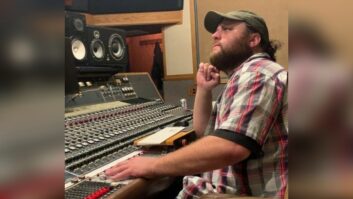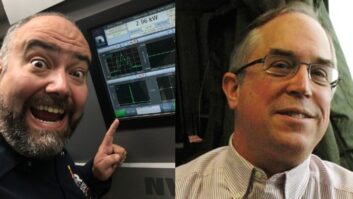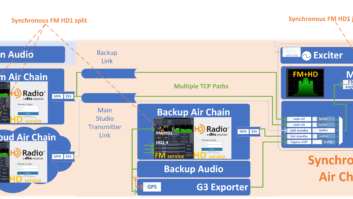

Cris Alexander is tech editor of RW Engineering Extra.
As I began editing the latest issue of RWEE, I couldn’t help taking another trip down memory lane, this time over the last 40+ years of FM air chain architecture.
Such reminiscences seem to come more often these days, and the words “Back in the day …” frequently elicit an eye roll from my daughter, who is CE of Crawford’s Denver cluster (though I think she secretly likes hearing about the “old stuff”).
So… let the eye rolls begin.
FM as stepchild
Back in the day… the FM stations at which I worked early on used simple air chain topography. The program bus of the on-air console fed, through a patch panel, a couple of pairs of CBS Laboratories audio processors: the Audimax and Volumax.
These were, if I recall correctly, discrete processors for left and right, although I think stereo versions were available at some point. If there was any kind of control linking between the mono pairs, I have long forgotten.
Those processors in turn, also through a patch panel, fed the Collins 310 exciter, which used a stereo generator card to create the multiplex signal.
Not a lot of radios could receive and decode the multiplex signal in those days. In fact, not a lot of radios could receive FM in those days!
FM was the stepchild, the “also-ran” to which not many paid a lot of attention. Which explains how I was able to land a job at a couple of FM stations before I even graduated high school.
I had an FM converter in my car for quite a while, which used an AM modulator to spit out a signal on the high end of the AM band where I could listen to the FM signal. It was mono, but I was way ahead of most folks just by being able to tune into those elevator music FM stations.
At some point, I bought and installed a car radio that had an integral FM tuner and a little red stereo light. I was amazed at the big stereo image when I first tuned into our FM station and that red light illuminated. That simple Audimax/Volumax air chain sounded pretty good!
Our little (but 100 kW!) FM station in the Texas Panhandle was a pretty low-budget operation, but when Orban came out with the Optimod 8000 in the 1970s, the owner sprang for one.
Installing it took some doing; the Collins exciter had to be reconfigured without the internal stereo generator, and I found out in a hurry that the multiplex cable between the composite output of the Optimod and the composite input of the exciter had to be pretty short if I wanted to have a good, wide stereo image.
Once I got the baseband and pilot levels adjusted to make the Belar FM and stereo monitors happy, I gave the station a listen in the car, and … wow!! That was my first exposure to multiband processing, and the on-air sound was amazing.
New methods
As time went on and I moved to the big city, I was exposed to other air chain topology.
I can’t recall working at any other stations that had collocated studios and transmitter site, so all used some kind of studio-to-transmitter link (STL). Many used equalized phone lines, but some used Marti discrete 950 MHz links.
Both those arrangements had their challenges. The phone lines would sometimes get noisy or hum, especially after a good rain, and the 950 MHz links were occasionally prone to noise and interference.
Audio processors were located at the transmitter site. By the late 1970s, all but one that I regularly dealt with used multiband processors. The sound was good, but not as good as that collocated Amarillo FM with its Optimod 8000.
And then I was hired as the chief (and only) engineer for a Dallas top 40 radio station. My transition into that job occurred at the same time as the station was transitioning to a new transmitter site and tower on the Cedar Hill antenna farm.
The studio was on a multistory building just east of downtown, and a 950 MHz Moseley composite STL was used to get the audio to the transmitter site. That was my first exposure to a composite STL, and I thought it very strange that the new Optimod 8100 processor was in the rack at the studio!
There was a loudness war underway in that very competitive market in those days, and we pretty much ran all knobs all the way to the right. But we needed more to stay ahead of — or even on a par with — our chief competition across town. The issue was overshoots in that composite STL; we had to keep the average modulation down to keep the peak modulation below 100%. The FCC had a field office in town, and they did pay attention to local broadcasters in those days.
Our parent company was New York-based, and it had connections, one of which was a brilliant engineer named Eric Small.
A mysterious “black box” of Mr. Small’s creation was placed in the air chain downstream of the STL receiver at the transmitter site, and that took care of the overshoots — we could run the modulation way up and stay out of trouble with the newfangled composite clipper in line. I knew it was working because I could see the pilot level dancing with modulation peaks.
Ethernet paths
That composite STL air chain architecture persisted for much of my career, until the digital age. We used various digital adapters on our composite links, including the Moseley DSP6000s, to good effect, and audio processors kept getting better.
In the early 1990s, a guy named Frank Foti came to Detroit with a weird-looking box that he called the Omnia. He installed it in the air chain of our FM station there, and … wow! Over the next 25 years, Frank’s processors kept getting better and we kept buying them.
Then came true all-digital STLs that offered transparent transmission paths between studio and transmitter. HD Radio appeared in the early 2000s, and the Tomorrow Radio Project made multicast channels on FM HD stations possible, requiring additional audio paths between studio and transmitter.
It was then that my company made the move to Part 101 bidirectional point-to-point microwave links, putting studios and transmitter sites on the same networks.
Air chains, for us, became Ethernet paths involving AoIP, NICs and switches, a far cry from those analog Audimax/Volumax patch-panel stereo generator chains of old.
Now we have even more options, one of which is multiplex over IP. In the latest issue of RW Engineering Extra, Tony Peterle of Worldcast Systems introduces us to MPXoIP technology.
As I enter my 45th year in the business, I can’t wait to see what comes next. How about RF over IP? Put the transmitter at the studio and send 40 kW of RF down a twisted pair … okay, we probably can’t do that ever. But it would sure be cool if we could!
You can reach the author at [email protected]. Cris Alexander, CPBE, AMD, DRB, is director of engineering at Crawford Broadcasting.












